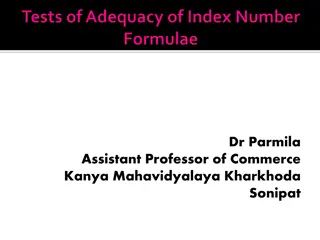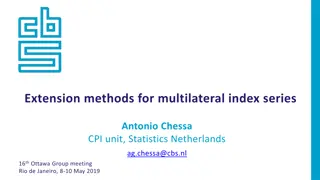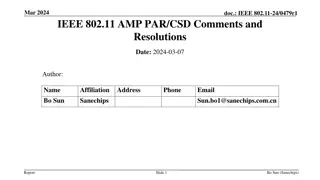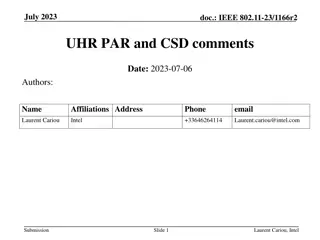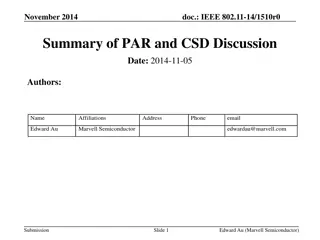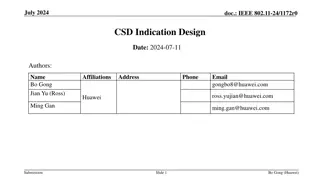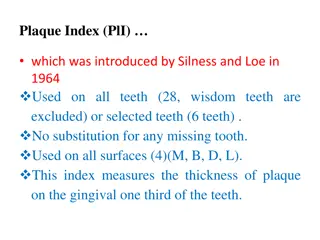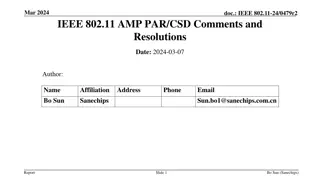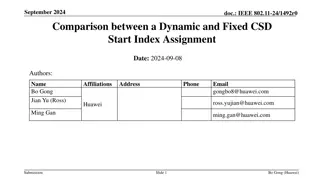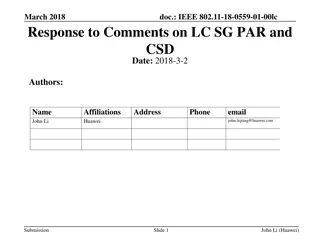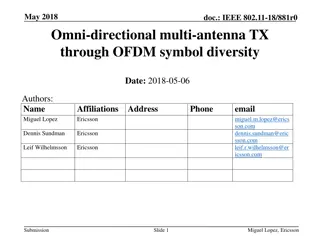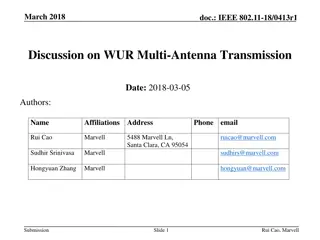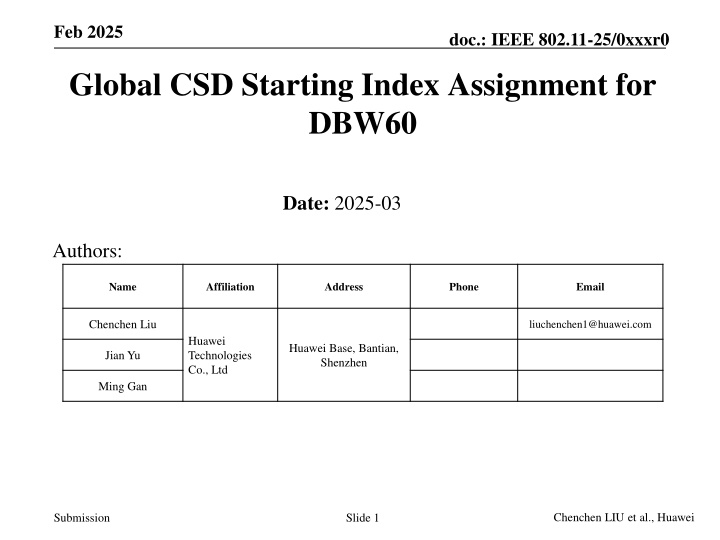
Optimizing Global CSD Index Assignment for DBW60 in IEEE 802.11-25/0xxxr0 Document
In this document, authored by Chenchen Liu and team from Huawei Technologies, the reuse of 8 CSD table values in 11ax/be for global CSD allocation is discussed to minimize signaling overhead. It addresses the challenges of reusing 80MHz DBW CSD index assignment for 60MHz and presents optimal CSD index assignments for different bandwidths. The document also outlines optimizations for global CSD index assignment, detailing valid DRU allocations and conducting an exhaustive search to optimize the assignment.
Download Presentation

Please find below an Image/Link to download the presentation.
The content on the website is provided AS IS for your information and personal use only. It may not be sold, licensed, or shared on other websites without obtaining consent from the author. If you encounter any issues during the download, it is possible that the publisher has removed the file from their server.
You are allowed to download the files provided on this website for personal or commercial use, subject to the condition that they are used lawfully. All files are the property of their respective owners.
The content on the website is provided AS IS for your information and personal use only. It may not be sold, licensed, or shared on other websites without obtaining consent from the author.
E N D
Presentation Transcript
Feb 2025 doc.: IEEE 802.11-25/0xxxr0 Global CSD Starting Index Assignment for DBW60 Date: 2025-03 Authors: Name Affiliation Address Phone Email Chenchen Liu liuchenchen1@huawei.com Huawei Technologies Co., Ltd Huawei Base, Bantian, Shenzhen Jian Yu Ming Gan Chenchen LIU et al., Huawei Submission Slide 1
Feb 2025 doc.: IEEE 802.11-25/0xxxr0 Introduction Global CSD has been used for DRU UHR-STF transmission to solve unintentional beamforming issue. We have decided to reuse the 8 CSD table/values in 11ax/be for global CSD allocation[1] To minimize signaling overhead, the DRU hierarchical structure will be utilized to indicate the global CSD starting index via the DRU index [2]. Chenchen LIU et al., Huawei Submission Slide 2
Feb 2025 doc.: IEEE 802.11-25/0xxxr0 Existing global CSD Assignments The optimal CSD index assignment minimizing CSD value collisions for DBW 20MHz, 40MHz, and 80MHz is presented in [2]. However, DBW 60MHz has not been addressed in the current design. Global CSD starting index for corresponded DRU Index 1 2 3 4 5 6 7 8 For DRU26 BW20 2 4 5 6 8 For DRU52 3 7 For DRU106 For DRU26 1 5 2 6 3 7 4 8 1 5 2 6 3 7 4 8 BW40 For DRU52 1 2 3 3 4 5 6 7 7 8 For DRU106 2 4 6 8 3 7 For DRU242 1 5 2 6 3 7 4 8 1 5 2 6 3 7 4 8 For DRU52 BW80 1 2 3 4 5 6 7 8 For DRU106 2 4 6 8 For DRU242 3 7 For DRU484 Chenchen LIU et al., Huawei Submission Slide 3
Feb 2025 Challenges of Reusing 80MHz DBW CSD Index Assignment for 60MHz doc.: IEEE 802.11-25/0xxxr0 1 5 2 6 3 7 4 8 1 5 2 6 3 7 4 8 For DRU52 1 2 3 4 5 6 7 8 For DRU106 BW80 2 4 6 8 For DRU242 3 7 For DRU484 For 60MHz DBW, the simplest approach would be to reuse the global CSD starting index mapping from 80MHz DBW. However, this would not minimize CSD value collisions. Specifically, collisions between large DRUs from the left 40MHz and 52-tone DRUs from the third 20MHz can be avoided. For example: The 106-tone DRU 1 and 52-tone DRU 9 share the same CSD starting index 1. The 242-tone DRU 1 and 52-tone DRU 11 share the same CSD starting index 2. The 106-tone DRU 5 and 52-tone DRU 11 share the same CSD starting index 2. Chenchen LIU et al., Huawei Submission Slide 4
Feb 2025 doc.: IEEE 802.11-25/0xxxr0 Global CSD Index Assignment Optimizations The valid DRU Allocation has 5*5*5=125 cases An exhaustive search was conducted according to the structure outlined below DRU52 ?1 ?2 ?3 ?4 ?5 ?6 ?7 ?8 ?1 ?2 ?3 ?4 DRU106 ?1 or ?2 ?3 or ?4 ?5 or ?6 ?7 or ?8 ?1 or ?2 ?3 or ?4 DRU242 ?1 or ?2 or ?3 or ?4 ?5 or ?6 or ?7 or ?8 ?1 or ?2 or ?3 or ?4 Note: Green and blue regions are restricted from sharing any CSD index. Chenchen LIU et al., Huawei Submission Slide 5
Feb 2025 doc.: IEEE 802.11-25/0xxxr0 Global CSD Index Assignment Optimizations The factors considered for searching The maximum number of STAs share the same CSD value, denoted as ??????? Total number of collisions over all the DRU allocation combinations, denoted as ?????????? Individual total number of collisions for 0-STA (no collision), 1-STA, 2-STA, , i-STA, share the same CSD value, denoted as ?? ??? The optimal value for both single and two streams ?????????? 130 1050 ??????? 2 3 ?0 ??? 3350 2585 ?1 ??? ?2 ??? ?3 ??? ?4 ??? Single stream Two stream 260 0 0 0 131 373 161 260 Chenchen LIU et al., Huawei Submission Slide 6
Feb 2025 doc.: IEEE 802.11-25/0xxxr0 Proposed global CSD index assignment for 60MHz DBW Because no single assignment can simultaneously achieve optimal performance for both Nss=1 and Nss=2, we propose two different approaches. Option 1 is optimized for Nss=1, yet suboptimal for Nss=2 1 2 7 4 3 6 5 8 6 2 4 8 52-tone DRU 106-tone DRU 1 7 3 5 6 4 242-tone DRU 1 3 6 Option 2 reuses the 80DBW approach with minor changes 1 5 2 6 3 7 4 8 7 5 8 6 52-tone DRU 106-tone DRU 1 2 3 4 5 6 242-tone DRU 2 4 6 Chenchen LIU et al., Huawei Submission Slide 7
Feb 2025 doc.: IEEE 802.11-25/0xxxr0 Performance evaluation Performance evaluation for the two options: ?????????? 130 130 1070 1105 180 1155 ??????? 2 2 3 4 2 4 ?0 ??? 3350 3350 2568 2553 3150 2549 ?1 ??? ?2 ??? ?3 ??? ?4 ??? Option1 (Nss=1) 260 260 158 155 360 133 0 0 0 0 0 0 Option2 (Nss=1) Option1 (Nss=2) 364 425 0 327 166 157 0 225 257 118 Option2 (Nss=2) Reuse DBW80(Nss=1) Reuse DBW80(Nss=2) 172 The comparation of the two options: Nss=1 Nss=2 implementation Has a good pattern, so only the CSD index for 52-tone DRU need to be stored Minor changes to existing table for 80DBW Option1 Optimal Suboptimal Option2 Optimal Not optimized Chenchen LIU et al., Huawei Submission Slide 8
Feb 2025 doc.: IEEE 802.11-25/0xxxr0 Summary In this contribution, we propose two global CSD starting index mapping for 60MHz DBW: Option 1 is optimized for Nss=1, yet suboptimal for Nss=2. Has a good pattern which can reduce the memory. Option 2 requires minimal modifications to reuse the existing 80DBW table. Optimal for Nss=1. Chenchen LIU et al., Huawei Submission Slide 9
Feb 2025 doc.: IEEE 802.11-25/0xxxr0 References [1] 11-24-0209-09-00bn-specification-framework-for-tgbn [2] 11-24-1188-02-00bn-global-csd-index-assignment-for-dru-stf-transmission- in-11bn Chenchen LIU et al., Huawei Submission Slide 10
Feb 2025 doc.: IEEE 802.11-25/0xxxr0 SP1 Do you support to include the following text to the 11bn SFD? Global CSD start index assignment of 60MHz DBW for DRU UHR-STR transmission will be based on the following table Global CSD starting index of DBW60 {1,2,7,4,3,6,5,8,6,2,4,8} {1,7,3,5,6,4,} {1,3,6} DRU size DRU52, i=1:16 DRU106, i=1:8 DRU242, i=1:4 Chenchen LIU et al., Huawei Submission Slide 11
Feb 2025 doc.: IEEE 802.11-25/0xxxr0 SP2 Do you support to include the following text to the 11bn SFD? Global CSD start index assignment of 60MHz DBW for DRU UHR-STR transmission will be based on the following table Global CSD starting index of DBW60 {1,5,2,6,3,7,4,8,7,5,8,6} {1,2,3,4,5,6} {2,4,6} DRU size DRU52, i=1:16 DRU106, i=1:8 DRU242, i=1:4 Chenchen LIU et al., Huawei Submission Slide 12



